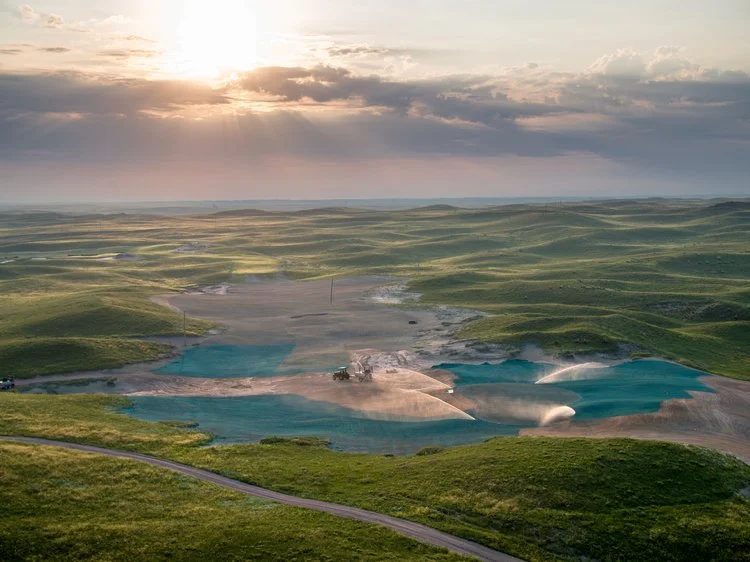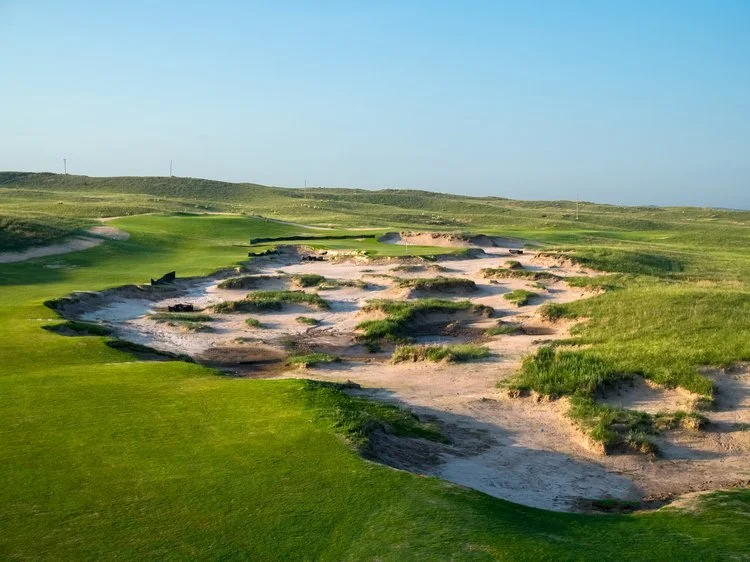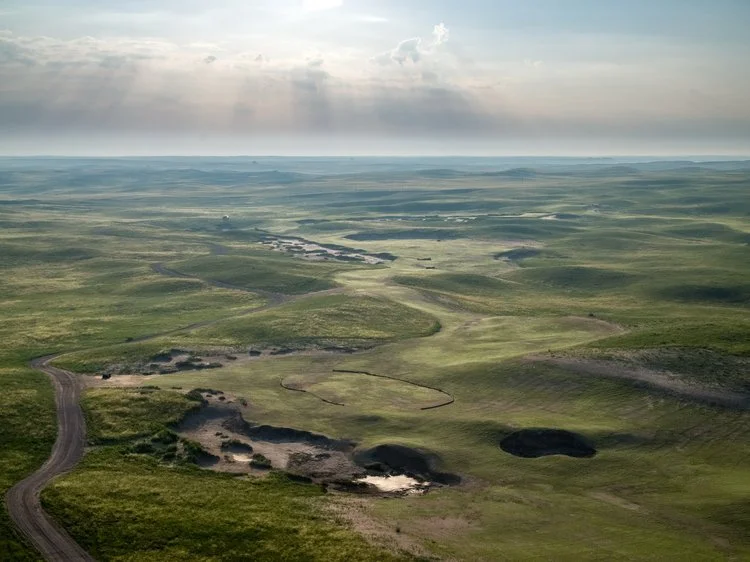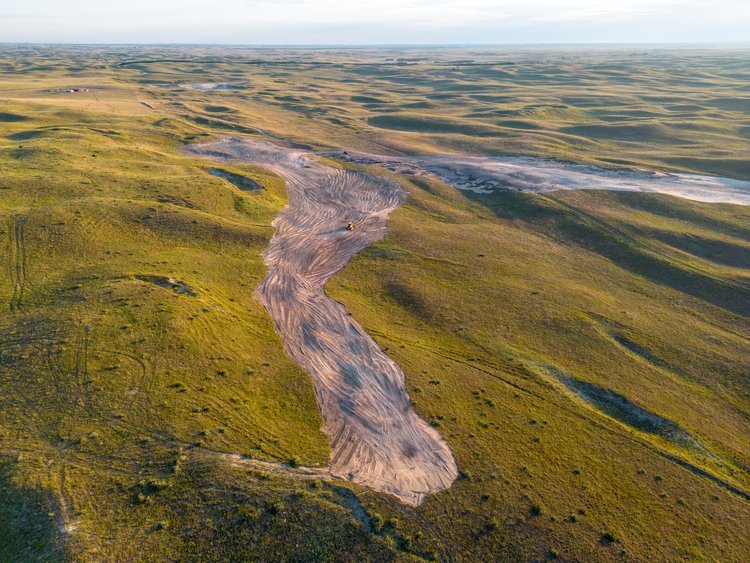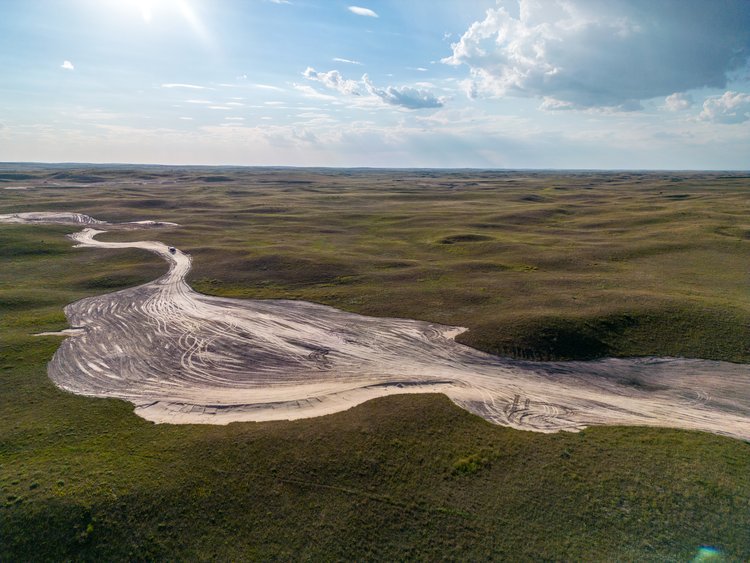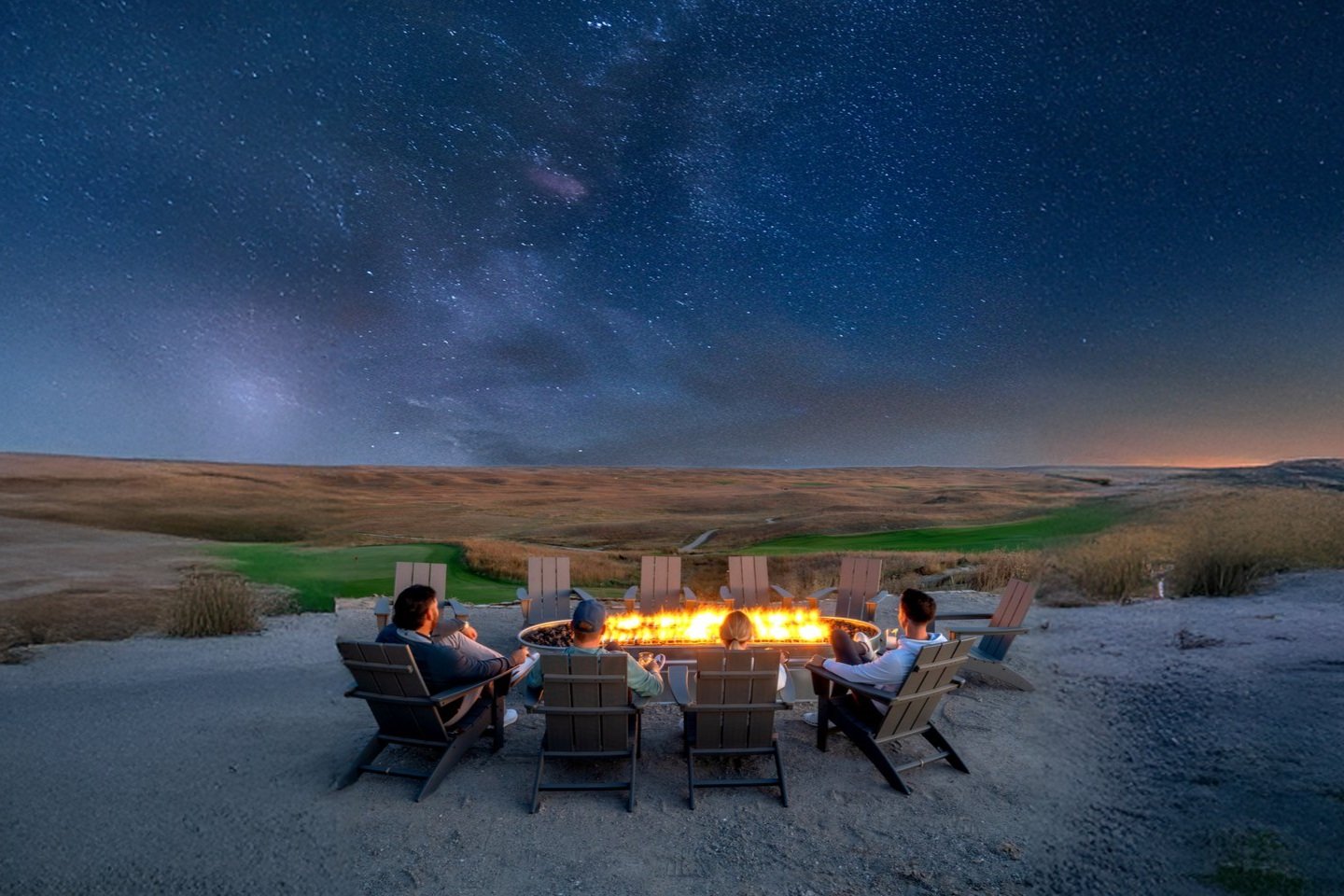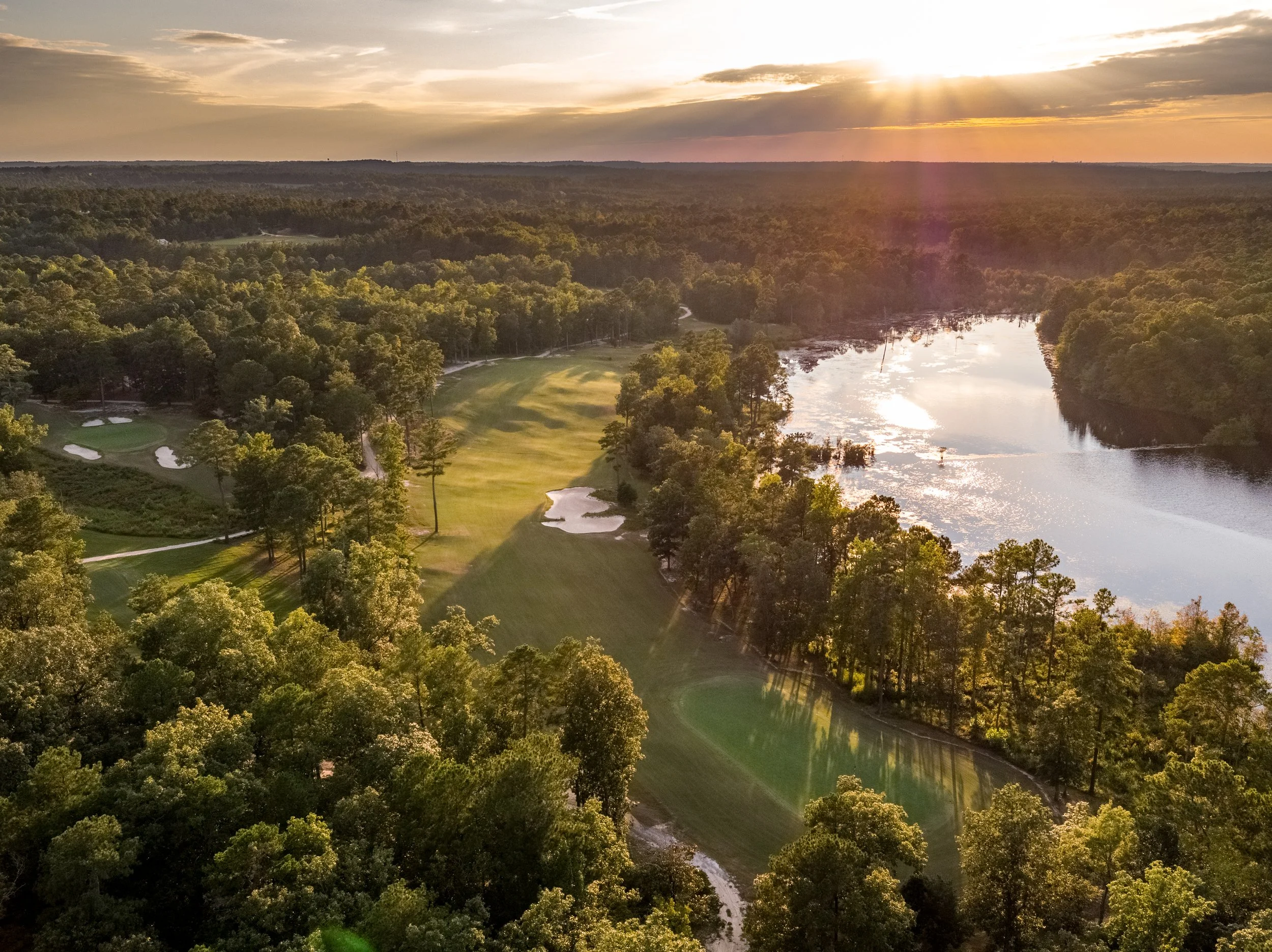A Majestic Home Run: GrayBull on Deck to Add Allure to Golf in the Sandhills
By John Steinbreder • Global Golf Post / GGPBiz • August 25, 2023
As I exit Interstate 80 and start driving north on the 56A Spur through this town of 312 residents, I cannot help but think I have seen this movie before. The expansive and cloudless cobalt-blue sky. The grassy hills on either side of the two-lane blacktop, pocked with natural blowout bunkers that expose the sand that lies underneath. The Aermotor windmills and clusters of Black Angus heifers sipping the water those mechanisms pump from the ground into circular steel tanks.
The road is narrow and curvy in places, so I strive to keep my eyes front. But I cannot stop glancing on occasion left and right. And when I do, I see golf holes. At least in my imagination. A par-3 here, with a tee perched on top of a stubby dune and a green set in a dale below. A 4-par there, with a fairway snaking between a pair of ridges. And I think back to the first time I ever ventured to the Nebraska Sandhills – which make up a 20,000-square-mile island that literally floats on top of a massive aquifer – and realized that this place boasts some of the best golf terrain on the planet. The hole sites I am now seeing are reminders of that.
My destination on that initial visit 20 years ago was Sand Hills Golf Club. Located outside the town of Mullen, Nebraska, it was created by a crusty Cornhusker named Dick Youngscap. And the layout he asked Bill Coore and Ben Crenshaw to design not only came to be regarded as a top-10 course but also initiated a renaissance in course architecture and a movement in site-driven golf course development that puts a premium on the quality of the land no matter where the location. Especially well-contoured terrain with sandy soil. It was a genius decision, and no one spoke more clearly to the quality of the ground in that region than Coore, who once told me that his biggest concern with the Sand Hills job was not screwing it up.
“Ben and I mapped out 136 holes on the 500 acres we were given to build the golf course,” he said. “That’s how amazing it was.”
Those words echo in my mind as I drive through the Sandhills once again. Only this time, my destination is a 2,000-acre site just north of Maxwell where David McLay Kidd is crafting an 18-hole course for the Dormie Network, a national association of private destination clubs, and its principals, Nebraska rancher and publishing magnate Tom Peed and his son, Zach. Dubbed GrayBull, it will be the seventh in their portfolio and the first in the Dormie Network to be built from the ground up. And what I discovered after a morning-long tour of the property, which is located 22 miles from the regional airport in North Platte, is that the links-style layout taking shape is going to be something special.
“You cannot get better ground … I had my choice of land to route the holes. The only restriction, if you would call it that, was the clubhouse site because they decided on that early on. Everything else was up for grabs.” - David McLay Kidd
Part of that will be a result of the land. “It’s Goldilocks,” said Kidd of the site he helped select. “Not too flat, not too steep. Wide-open property that is far enough outside North Platte to be wilderness, but not so far that you are squirming in your seat driving there.
“You cannot get better ground,” the 55-year-old architect added. “And with the Peeds only wanting to build one 18-hole course, I had my choice of land to route the holes. The only restriction, if you would call it that, was the clubhouse site because they decided on that early on. Everything else was up for grabs.”
Kidd is also enamored of the routing and how it flows with minimal interruptions.
“Once you get to the first tee, you never leave the grass,” he said. “Carts are available, but there are no cart paths, and what I think we have is a really exciting golf exploration that allows players to immerse themselves in this incredible landscape.
“Initially, I tried to do a routing on paper but failed miserably. There were just so many ways to create one given all the land we had. So, we took to walking the property, over and over and over again, to find the best one.”
And though this is the first time Kidd has worked in Nebraska, the native Scot is in many ways the perfect choice for the project, considering the Bandon Dunes course he designed in southern Oregon soon after Coore and Crenshaw crafted Sand Hills is equally as important an instigator of the site-driven revival.
Work on the GrayBull track began in June 2022.
There will be no cart paths at GrayBull, and as a glimpse of the future fifth and sixth holes displays, it is turf worth traveling.
“There were just four of us in the beginning,” said construction manager Chip Caswell, who has helped Kidd build courses in Nicaragua (Guacalito de la Isla) and Washington state (Gamble Sands). “We are just about done grassing and, in the end, will have about 100 acres of turf. The goal is to have 100 percent turf coverage before winter. That way, we can be ready for preview play next August.”
On my morning July visit, dawn is just breaking as the 56A Spur turns from asphalt to dirt. Soon after, I pass what will be the club entrance and a sign designating it as “Dormie Road.” Then I drive to an area that serves as project headquarters and is full of trailers and various types of vehicles, from pick-up trucks and backhoes to bulldozers and Kawasaki Mules. Early in the morning as it may be, it is already bustling as members of the construction and irrigation crew, which consists of some 40 workers, begin making their way onto the course site to undertake their assignments for the day. Two men will be shaping the 16th and 17th greens. Others will be seeding fairways that are ready to be grassed or putting the finishing touches on bunkers.
No. 1 (left) and No. 2 offer a crude look at what promises to be a rugged start at GrayBull.
“We are grinding over every detail,” said Caswell as he gives me a rollicking tour in a Mule. “Every hole has to look cool, drain well and function properly for golf, and that includes everything from golfer traffic to how we want the golf ball to react on the ground.
“As a result, we spend a lot of time on the ground. David and I walk this property all the time, and I translate a lot of what we discuss to the shapers, so we can make the necessary adjustments. Then he weighs in on what we’ve done.”
We stop at the clubhouse site, which sits atop an ample dune and affords views of the Sandhills that stretch out in all directions. Gazing across them, I think of the pioneer writer who described this terrain as “frozen waves of prairie ocean.” Looking at the foundation that has recently been poured at what is the first edifice to rise on the site, I also imagine what the clubhouse will be like once it is completed and how good the quality of the “hang” will be.
Caswell tells me that the par-72 course at GrayBull will feature multiple tees on each hole, so it can play as long as 7,100 yards and as short as 4,800. That way, it can accommodate a wide range of players.
“And because this will be a private club and part of a private club network with mostly members playing, we want to make the ability to score on GrayBull a little tougher than some of my more recent courses, like Mammoth Dunes and Gamble Sands, which are entirely public,” Kidd said.
“The fairways might be a little tighter, especially in the places where the better players will hit their drives, and the greens a little smaller.”
As for the Peeds not wanting to build another 18-hole layout or even a short course, Kidd said: “They just want an exceptional golf course and an equally outstanding practice facility.”
In driving around the course with Caswell, I marvel at the sense of place. The two Aermotor windmills that stand on the grounds. The sections of fences from the days when the property was divided into pastures. The different holes, and the ways they are designed to test the skills of golfers and make them think their ways around the course while also giving them wonderfully fun shots to hit.
Now 55 years old, Caswell can sense my excitement as to what this place will be when it is open. And he smiles as he tells me he has been feeling the same way since he started moving ground at GrayBull.
“Not many people get the chance to build a course in the Nebraska Sandhills,” he said. “We have a home-run site, and to be able to do this with David is special. I tell the young guys in the crew all the time that this is as good as it gets.”
I have a feeling that when Kidd, Caswell and their colleagues are done, Dormie Network golfers will be saying much the same thing.

